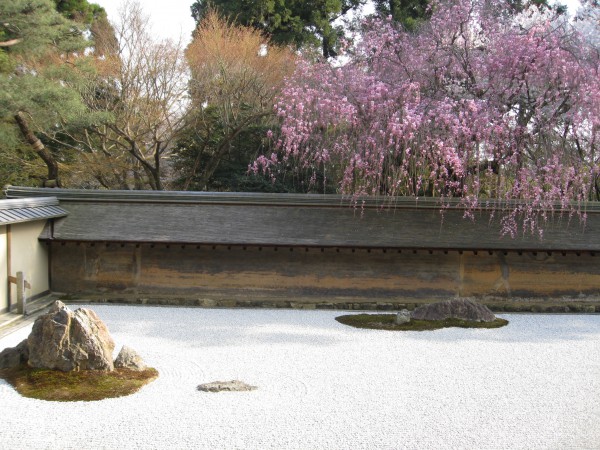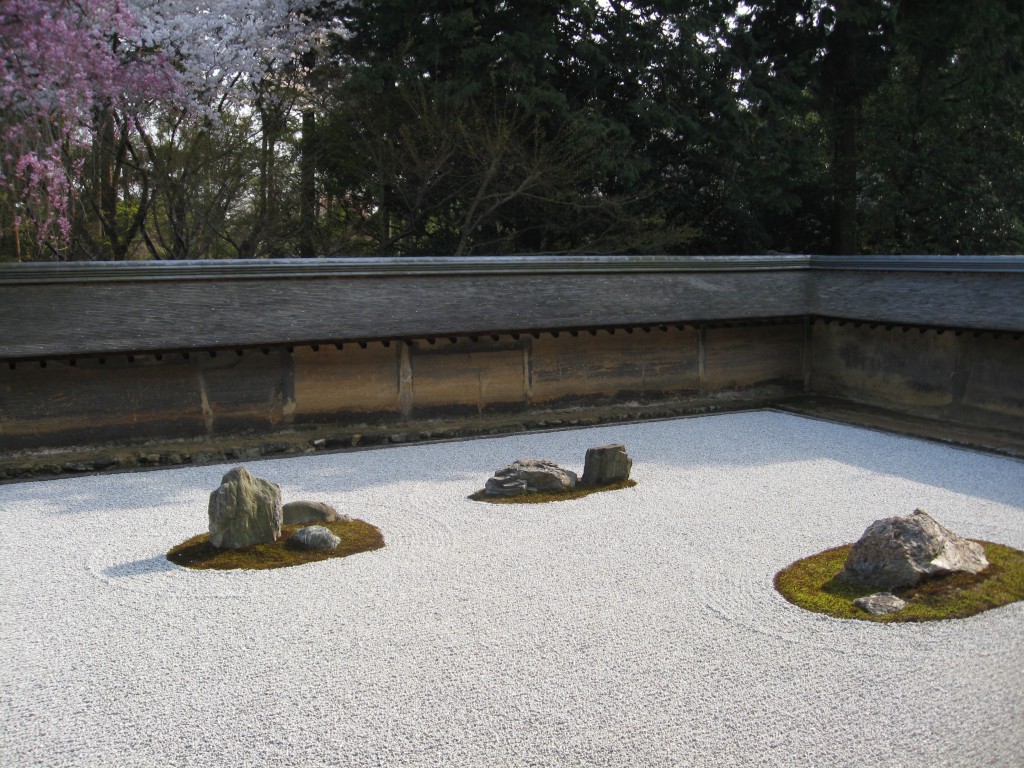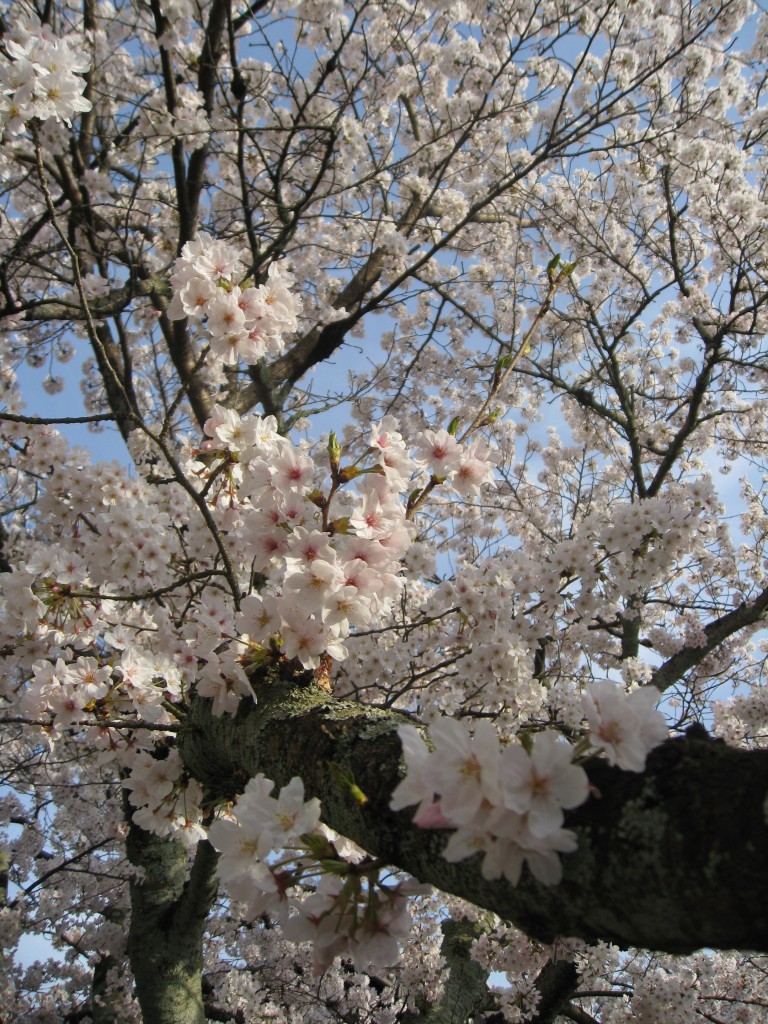For those who follow the teachings of Zen, one must not merely look, but see—and hear. I’m not the meditating type, but the extreme spareness of Ryōan-ji, the dry-landscape Japanese garden in Kyoto, with its solid wall and graceful overhanging branches of cherry blossom—an extraordinary place of art—encouraged me to silently contemplate the meaning of its stillness. This is not a pleasure garden to stroll through …
Most forms of Japanese gardens originated around Shinto shrines and are an external expression of the Shinto respect for nature and the Buddhist ideal of paradise. Although one must not look for recognisable forms in a Japanese dry-landscape garden, it is a reflection of the natural world: large solitary rocks and boulders set among smooth raked gravel look like mountains and the ocean. In fact, the layout of the Ryoan-ji garden has been interpreted by some to be ‘The Great Ocean’ upon which one can meditate on the ‘waves’ during one’s life journey. The large stones are said to emulate the islands in the Sea of Japan, representing the ‘Islands of the Taoist Immortals’; the horizontal flat stones are often thought to represent a ‘Seat of the Gods’ to accommodate the Japanese Shinto kami spirits.
But viewers of the Ryoan-ji garden are encouraged to be open to what the garden can be instead of trying to work out symbolism or preconceived imagery. This is similar to viewing any work of art, whether a sculpture, a painting, or a decorative work, where one is tempted to read the explanation on the label before responding to the work on an individual basis.
As I have written in an earlier post, the subject matter of traditional Japanese art is predominantly nature-related. Wabi (the quality of frugality/restrained beauty)and sabi (patina of age/veil of antiquity) relate to Japanese aesthetics and the belief that beauty can be seen in the irregular, the asymmetrical and the imperfection of natural materials, which ultimately achieves a higher state of expression—‘zen’. The viewer has to draw out the inner beauty (shibui) for him or herself, and that can only happen if he or she focuses.
Due to the idea that a Zen garden is one with nature, the design follows a natural order with odd numbered plants, rocks and an irregular placement of objects. This contrast is believed to create an energy and sense of movement between elements in the garden that brings harmony, with no central object within the garden on which to focus. Instead, multiple simplistic objects allow viewers to focus on the relationship created between them.
On 6 April 2010 I left the busy road outside and entered Ryoan-ji, a Zen temple that houses one of the finest examples of kare-sansui, or dry garden, in the world. It was as if the soul of Japan was waiting for me. Founded around 1425, the garden measures 25 metres by 10 metres, and the rectangle of white gravel is raked by the monks each day. Fifteen rocks of varying sizes have been carefully grouped amongst the gravel and the only vegetation is moss. The enigmatic arrangement of fifteen rocks is attributed to the fifteenth-century garden architect, Soami, who carefully selected each rock and placed them in relationship with each other and the plant material, so that shapes, textures and colour harmonise. Some say that the entire composition of the garden and rocks cannot be viewed from just one angle—and that one would attain enlightenment if able to view the fifteenth boulder. This garden encourages silent contemplation; the surrounding masonry wall capped by roof tiles dissociates the space from background trees and separates the visitor from the world outside—the verandah opposite provides an opportunity to view the stillness of the garden from a seated position.
I found it therapeutic to concentrate, and block out the constant noise and distractions of our world today. But we are so attuned to our smartphones and chatter that most of the time we’re desperate to be distracted and gladly embrace interruptions. As the seventeenth-century French philosopher, Blaise Pascal, wrote: “All of humanity’s problems stem from man’s inability to sit quietly in a room alone.” Buddhism seeks, as I understand it, the achievement of stillness in oneself.
The power of all Zen art lies in its minimalism, and so Japanese dry-landscape gardens, such as Ryōan-ji, suggest more than they define. Like the visible brushwork of ink on paper, the abstract arrangement of the stones and rocks serves as an aid to meditation, silencing the mind and concentrating on the stillness of the forms rather than inflicting interpretations on them. This garden, the ultimate expression of Zen Buddhism, is spiritual without being didactic, and natural at the same time it is artistic. I found myself thinking about the human inter-relationship with nature and its inorganic forms, and observing the stillness in the hope of unravelling some sort of riddle, even when there was noise and activity all around me.
“For after all what is man in nature? A nothing in relation to infinity, all in relation to nothing, a central point between nothing and all and infinitely far from understanding either. The ends of things and their beginnings are impregnably concealed from him in an impenetrable secret. He is equally incapable of seeing the nothingness out of which he was drawn and the infinite in which he is engulfed.”
Blaise Pascal, Pensées, No. 72








Beautiful. Thankyou.
I appreciate your response, Nita. Thank you.
[…] If you are interested in Zen gardens, you will find this highly recommended article here: Denise M Taylor […]